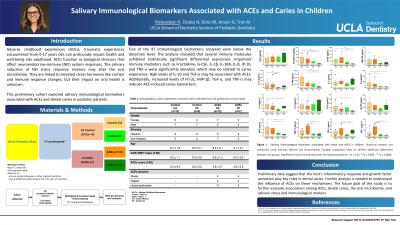Caries
356 - Salivary Immunological Biomarkers Associated with ACEs and Caries in Children


Payton Richardson, DDS
Pediatric Dental Resident (PGY-2)
University of California, Los Angeles
University of California, Los Angeles
Los Angeles, California, United States- NT
Nini Tran, DDS
Assistant Professor
University of Califronia, Los Angeles
Los Angeles, California, United States - GA
Ghassem Ansari, D.D.S., M.Sc., Ph.D., A.P.P.D
Clinical Professor
University of California, Los Angeles
Los Angeles, California, United States
Presenting Author(s)
Research Mentor(s)
Program Director(s)
Purpose: Adverse Childhood Experiences (ACEs) are traumatic events that affect health from
childhood to adulthood. They are linked to elevated stress hormones and immune
response changes, but their impact on oral health is unknown. This study explored salivary
immunological biomarkers associated with ACEs and dental caries in children. adverse childhood experiences (ACEs ≥1) and 22 without ACEs (control group, ACEs =0). The ACEs score was determined based on the results of the ACEs questionnaire. Comprehensive oral evaluation was conducted to assess the number of decayed (d/D), missing (m/M), and filled (f/F) teeth (t/T). Samples were categorized into 4 groups based on caries, caries-affected (CA) or caries-free (CF), and ACEs scores (ACEs=0 or ≥1). Salivary immunological biomarkers were analyzed using a multiplexed bead immunoassay (Luminex). analysis revealed that several immune molecules exhibited statistically significant differential expression. Important immune mediators such as Fractalkine, G-CSF, IL-1 , IL-1RA, IL-8, IP-10, and TNF-alpha were significantly elevated, which may be related to caries experience. High levels of IL-10 and TGF-alpha may be associated with ACEs. Additionally, increased levels of Ftl-3L, MIP-1Beta, TGF-alpha, and TNF-alpha may indicate ACE-induced caries biomarkers.
Methods: Unstimulated saliva was collected from 41 children aged 5 to 11 years, with 19 having
Results: Five of the 47 immunological biomarkers analyzed were below the detection level. The
Conclusions: Preliminary data suggest that the host’s inflammatory response and growth factor activation play key roles in dental caries. Further analysis is needed to understand the influence of ACEs on these mechanisms.
Identify Supporting Agency and Grant Number:

.jpg)